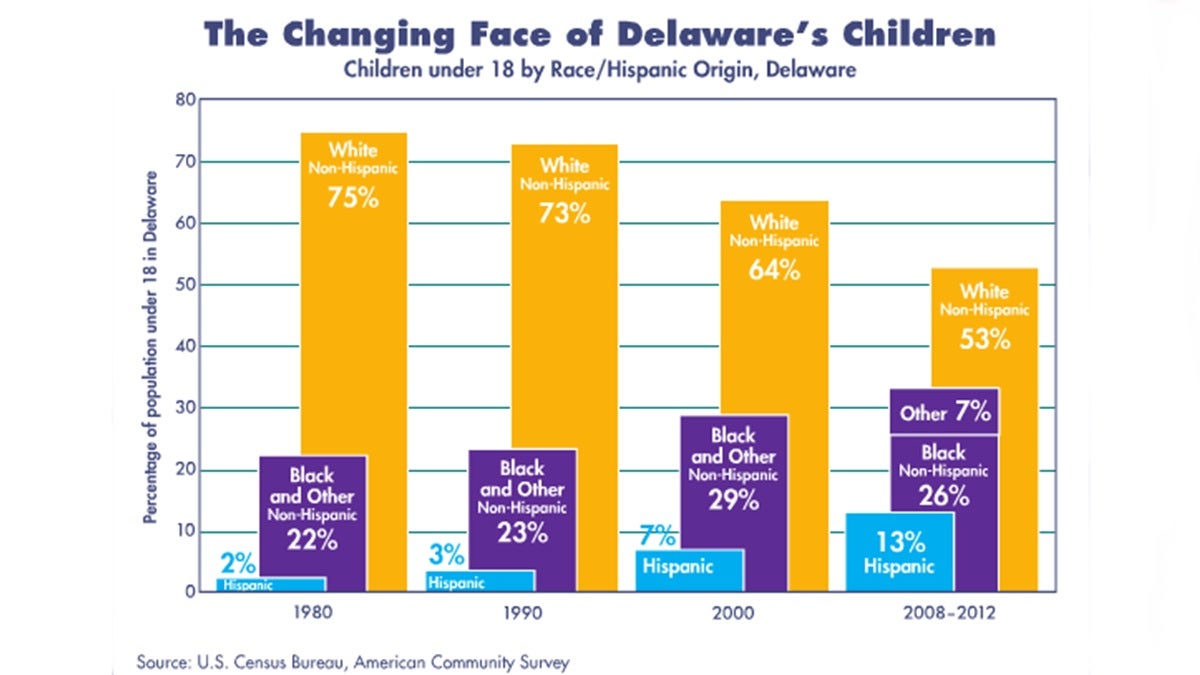Report: Delaware’s children are increasingly diverse
Listen
This graph from the Kids Count Fact Boook shows the growing diversity among Delaware children. (image courtesy Kids Count DE)
The latest Kids Count Fact Book highlights the demographic shifts of Delaware’s young people.
The annual report, which will be officially released on Monday, updates statistics related to Delaware’s children and demonstrates their growing racial diversity.
In 2000, 64 percent of Delawareans under the age of 18 were classified as white, non-Hispanic. At that time, African-American and other non-Hispanic children made up 29 percent of the population under 18, while Hispanic children accounted for just 7 percent.
A decade later, white, non-Hispanic children make up just 53 percent of the under 18 population. African-American children account for 26 percent, Hispanic children represent 7 percent and other non-white, non-hispanic children make up 7 percent.
“Children in Delaware are becoming more and more diverse,” said Janice Barlow, director of Kids Count Delaware. “Right now, they’re the most diverse ever.”
Nationally, the number of children of color is expected to outnumber the number of white children born by the year 2018. Barlow said the growing diversity has an impact on the state, especially in areas where there is a gap in performance between white and non-white groups.
“There are several places where we see very dramatic disparities in the numbers,” she said. “As our population of people of color grow, we really need to address those disparities in order to be prosperous for the future.”
Infant mortality
One area of disparity continues to be infant mortality. Delaware’s infant mortality rate of 8.1 deaths per thousand births is above the national rate of 6.4. When broken down by race, the mortality rate for black children is 13.8 versus 5.8 for white children.
“When we look at the disparities, black babies are still almost twice as likely as white or Hispanic babies to be born at low birth weight or to die within the first year,” Barlow said.
The state’s rate of low birth weight stands at 8.8 per thousand births, which is also above the national average. Low birth weight often correlates to infant mortality, but it can also have long-term impacts on babies that survive.
“It is very highly linked to developmental delays, so we’re talking educational and health and other outcomes,” Barlow said.
Growing poverty
Another area of concern are growing rates of poverty among Delaware children. The latest numbers show that 20.6 percent of Delaware’s children live in poverty, a number that nearly doubled since the economic downturn occurred in 2008.
“Poverty really does impact kids in education: It impacts their safety and their health; it really affects all of the other indicators that we report on in our book,” Barlow said.
While addressing childhood poverty is a more complicated task when compared to reducing infant mortality rates, Barlow insisted that state leaders need to figure out a way.
“If it was easy, it would have already been done,” she observed. “We have to invest in [children’s] health, their education, in their communities, in their families, from a variety of directions if we want to help this trend.”
The Kids Count Fact Book will be posted online on Monday and can be found here. Once released, it will be available for policy makers, child advocates and other stakeholders or, as Barlow said, “anyone who is interested in taking action on an issue that affects a child.”
Barlow emphasized that data is the first step in understanding an issue.
“And that’s where we come in,” she said. “We can provide that, and then the action is the next step.”
—-
You can see the interview with Janice Barlow on WHYY’s First this Friday night at 5:30 and 11 p.m. The full show will be available online Monday afternoon at WHYY.org/First.
WHYY is your source for fact-based, in-depth journalism and information. As a nonprofit organization, we rely on financial support from readers like you. Please give today.





